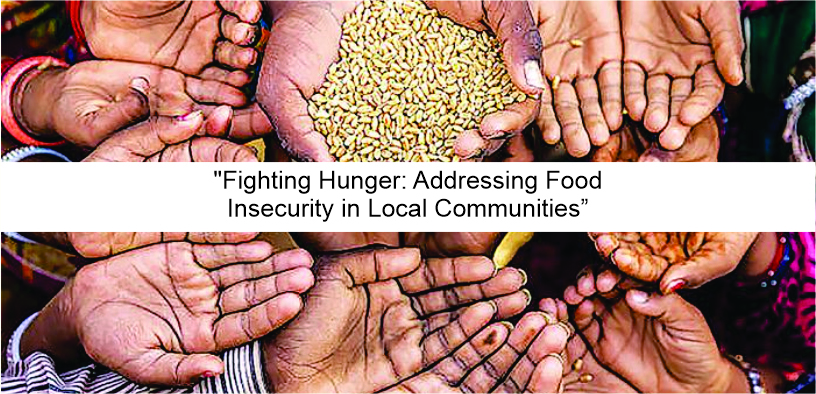In the face of burgeoning populations, unequal distribution of resources, and the debilitating impacts of climate change, the specter of food insecurity looms large over much of the developing world. This concern is palpably acute in India, a country with a population exceeding 1.3 billion. Amidst a rich tapestry of cultural, economic, and geographic diversity, the nation struggles with ensuring sufficient, reliable access to safe and nutritious food for all citizens. This article examines the contours of this challenge and discusses possible solutions, demonstrating how community-based organizations can make a substantial difference in this scenario.
Understanding Food Inequality in India
Food insecurity or inequality, at its core, refers to the inability of people to access adequate food for a healthy and active life, either due to unaffordability or unavailability. As per the Global Hunger Index, India ranks alarmingly high, underscoring the gravity of this issue. Multiple factors, including poverty, lack of education, gender inequality, and inefficient supply chains contribute to this problem. However, every problem contains within itself seeds of its own solution, and addressing food insecurity is no different.
Strategies for Combating Food Insecurity
To address food insecurity, a multi-pronged, holistic approach is necessary. This includes improving agricultural productivity, streamlining supply chains, educating communities about nutrition, and involving government and non-governmental organizations in targeted interventions.
Enhancing Agricultural Productivity
Agriculture is the backbone of India’s economy, employing nearly half of its workforce. However, many farmers operate on small, unprofitable landholdings, using outdated technologies and facing unpredictable weather patterns due to climate change. Investments in modern farming techniques, climate-resilient crop varieties, and micro-irrigation systems can increase crop yields significantly. Additionally, providing farmers with easy access to credit and insurance will enable them to take risks, innovate, and thus boost productivity.
Streamlining the Supply Chain
India loses a considerable portion of its agricultural produce due to inefficient supply chains and inadequate storage facilities. Modernizing these logistics will reduce food waste and ensure more food reaches the markets. Public-private partnerships can facilitate investments in cold storage facilities, refrigerated transportation, and digital platforms for connecting farmers directly with retailers, thereby eliminating middlemen.
Nutrition Education
While increasing food availability is essential, so is improving its utilization. Many Indian households lack knowledge about balanced diets, leading to malnutrition despite food availability. School-based and community nutrition education programs can play a pivotal role in changing dietary habits and enhancing understanding of the importance of a balanced diet.
Involving Community-Based Organizations
Community-based organizations can be instrumental in tackling food insecurity. They understand local contexts, can offer tailored solutions, and have established trust within the community. They can aid in implementing government schemes, conducting nutrition education programs, and even running community kitchens.
The Role of NGO
NGOs like Narayan Seva Sansthan (NSS) are an example of a community-based organization making a difference. While primarily known for its work in providing free surgeries for polio-affected individuals, NSS also runs food assistance programs. It steps in during crises like the COVID-19 pandemic to provide food relief packages to vulnerable families, demonstrating how NGOs can supplement government efforts to alleviate hunger.
Governmental Initiatives
Government initiatives also play a crucial role in addressing food insecurity. The Public Distribution System (PDS), the Mid-Day Meal Scheme, and the Integrated Child Development Services (ICDS) are all designed to address food insecurity in India. However, issues such as corruption, leakages, and inefficiencies often plague these well-intentioned initiatives. Strengthening these systems through better monitoring, increased transparency, and leveraging technology can help these programs reach their intended beneficiaries more effectively.
Conclusion
Addressing food insecurity in India is a daunting challenge. Yet, it is not insurmountable. By leveraging the country’s agricultural potential, modernizing supply chains, promoting nutrition education, and harnessing the power of both governmental and non-governmental organizations, India can move towards a future free from hunger. And as the efforts of organizations like the Narayan Seva Sansthan show, every initiative counts in this noble pursuit. You can also become a part of this initiative by donating to Narayan Seva Sansthan.
FAQ
1. What is food insecurity and why is it a concern in India?
Food insecurity refers to the lack of consistent access to enough food for an active, healthy life. It’s a significant concern in India due to a combination of factors such as population growth, poverty, lack of education, gender inequality, and inefficient food supply chains. According to the Global Hunger Index, India ranks high on the list of countries affected by food insecurity, demonstrating the urgency of this issue.
2. How can agricultural productivity be improved to address food insecurity?
Improving agricultural productivity can be accomplished by investing in modern farming techniques, promoting the use of climate-resilient crop varieties, and implementing micro-irrigation systems. Moreover, providing farmers with better access to credit and insurance allows them to innovate and take calculated risks, leading to increased productivity.
3. What role does the supply chain play in addressing food insecurity?
The supply chain plays a significant role in addressing food insecurity. Much of India’s agricultural produce is lost due to inefficient supply chains and inadequate storage facilities. By modernizing these logistics, reducing food waste, and ensuring more food reaches the markets, the issue of food insecurity can be substantially alleviated.
4. How can the government contribute to addressing food insecurity?
Government initiatives are vital in addressing food insecurity. Programs like the Public Distribution System (PDS), the Mid-Day Meal Scheme, and the Integrated Child Development Services (ICDS) are designed to address food insecurity in India. However, these programs often face issues such as corruption, leakages, and inefficiencies. Strengthening these systems through better monitoring, increased transparency, and leveraging technology can help these programs reach their intended beneficiaries more effectively.








